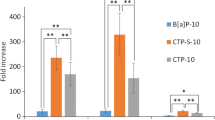Summary
Benzo(a)pyrene (BP) metabolism has been studied in epidermal blisters maintained in a culture medium for 24 h and 48 h. The viability of the cells has been assayed by [3H]proline incorporation into proteins and by [14C]BP metabolism into unconjugated metabolites. A screen of BP metabolism in 19 individuals shows a great variation of basal epidermal activity. Induction of BP metabolism by the application of coal tar 24 h before the epidermal blister sampling, resulted in two- to eight-fold increase in BP metabolism. This induction is not increased when the coal tar application is repeated.
Similar content being viewed by others
References
Bickers DR, Kappas A (1978a) Human skin aryl hydrocarbon hydroxylase: Induction by coal tar. J Clin Invest 62:1061–1068
Burke MD, Mayer RT (1974) Ethoxyresorufin: direct fluorimetric assay of a microsomal O-dealkylation which is preferentially inducible by 3-methylcholanthrene. Drug Metab Dispos 2:583–588
Buty SG, Thompson S, Slaga TJ (1976) The role of epidermal aryl hydrocarbon hydroxylase in the covalent binding of polycyclic hydrocarbon to DNA and its relationship to tumor initiation. Biochem Biophys Res Commun 70:1102–1108
Chapman PH, Rawlins MD, Shuster S (1979) The activity of AHH in human skin. Br J Clin Pharmacol 7:499–503
De Graeve J, Kremers P, Frankinet C, Gielen JE (1980) A new highly sensitive assay for ethoxycoumarin deethylase in cultured hepatocytes. Anal Biochem 104:419–424
Finnen MJ, Shuster S, Lawrence CM, Rawlins MD (1983) Aryl hydrocarbon hydroxylase activity and psoriasis. Biochem Pharmacol 32:1707–1711
Finnen MJ, Lawrence CM, Shuster S (1984) Human skin aryl hydrocarbon hydroxylase. Br J Dermatol 110:339–342
Heidelberger C (1975) Chemical carcinogenesis. Annu Rev Biochem 44:79–121
Kuroki T, Nemoto N, Kitano Y (1980) Metabolism of benzo(a)pyrene in human epidermal keratinocytes in culture. Carcinogenesis 1:559–565
Kuroki T, Hasami J, Munakata K, Onizuka T, Terauchi M, Nemoto N (1982) Metabolism of benzo(a)pyrene in epidermal keratinocytes and dermal fibroblasts of humans and mice with reference to variation among species, individuals, and cells types. Cancer Res 42:1859–1865
Lowry O, Rosebrough N, Farr A, Randall R (1951) Protein measurement with the folin phenol reagent. J Biol Chem 193:265–275
Manil M, Van Cantfort J, Lapière CM, Gielen JE (1981) Significant variations of mouse skin aryl hydrocarbon hydroxylase inducibility as a function of the hair growth cycle. Br J Cancer 43:210–221
Merck H, Rumpf M, Bobazn K, Wirth G, Goertz G (1984) Inducibility of aryl hydrocarbon hydroxylase activity in human hair follicles by topical application of liquor carbonis detergens (coal tar). Br J Dermatol 111:279–284
Mukhtar H, Link CM, Cherniack E, Kushner DM, Bickers DR (1982) Effect of topical application of defined constituents of coal tar on skin and liver aryl hydrocarbon hydroxylase and 7-ethoxycoumarin deethylase activities. Toxicol Appl Pharmacol 64:541–548
Nebert DW, Gielen JE (1972) Genetic regulation of aryl hydrocarbon hydroxylase induction in the mouse. Fed Proc 31:1315–1325
Pannatier A, Jenner P, Testa B, Etter JC (1978) The skin as a drug metabolizing organ. Drug Metabol Rev 8:319–343
Rawlins M, Shuster S (1982) Aryl hydrocarbon hydroxylase in psoriasis. Lancet 2:271
Shuster S, Rawlins MD, Chapman PH, Rogers S (1980) Decreased epidermal aryl hydrocarbon hydroxylase and localized pustular psoriasis. Br J Dermatol 103:23–26
Van Cantfort J, De Graeve J, Gielen JE (1977) Radioactive assay for aryl hydrocarbon hydroxylase. Improved method and biological importance. Biochem Biophys Res Commun 79:505–512
Weisburger EK (1978) Mechanism of chemical carcinogenesis. Annu Rev Pharmacol Toxicol (Copenh) 18:395–415
Author information
Authors and Affiliations
Rights and permissions
About this article
Cite this article
Van Cantfort, J., Lorand, T., Gielen, J.E. et al. Human epidermal blister: A convenient tissue for toxicological and genetic studies of benzo(a)pyrene metabolism. Arch Dermatol Res 278, 324–328 (1986). https://doi.org/10.1007/BF00407747
Received:
Issue Date:
DOI: https://doi.org/10.1007/BF00407747




